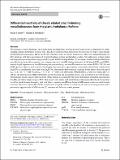Files in this item
Differential reactivity of closely related zinc(II)-binding metallothioneins from the plant Arabidopsis thaliana
Item metadata
| dc.contributor.author | Imam, Hasan T. | |
| dc.contributor.author | Blindauer, Claudia A. | |
| dc.date.accessioned | 2017-12-20T12:30:15Z | |
| dc.date.available | 2017-12-20T12:30:15Z | |
| dc.date.issued | 2018-01 | |
| dc.identifier | 251808519 | |
| dc.identifier | 6bb9c4c2-a968-40c5-8268-b360b7a8d306 | |
| dc.identifier | 85037350096 | |
| dc.identifier | 000419596000012 | |
| dc.identifier.citation | Imam , H T & Blindauer , C A 2018 , ' Differential reactivity of closely related zinc(II)-binding metallothioneins from the plant Arabidopsis thaliana ' , Journal of Biological Inorganic Chemistry , vol. 23 , pp. 137-154 . https://doi.org/10.1007/s00775-017-1516-6 | en |
| dc.identifier.issn | 0949-8257 | |
| dc.identifier.uri | https://hdl.handle.net/10023/12362 | |
| dc.description | Support by Advantage West Midlands and the European Regional Development Fund (Birmingham Science City) is gratefully acknowledged. | en |
| dc.description.abstract | The dynamics of metal binding to and transfer from metalloproteins involved in metal homeostasis are important for understanding cellular distribution of metal ions. The dicotyledonous plant Arabidopsis thaliana has two type 4 seed-specific metallothionein homologues, MT4a and MT4b, with likely roles in zinc(II) homeostasis. These two metallothioneins are 84% identical, with full conservation of all metal-binding cysteine and histidine residues. Yet, differences in their spatial and temporal expression patterns suggested divergence in their biological roles. To investigate whether biological functions are reflected in molecular properties, we compare aspects of zinc(II)-binding dynamics of full-length MT4a and MT4b, namely the pH dependence of zinc(II) binding and protein folding, and zinc(II) transfer to the chelator EDTA. UV–Vis and NMR spectroscopies as well as native electrospray ionisation mass spectrometry consistently showed that transfer from Zn6MT4a is considerably faster than from Zn6MT4b, with pseudo-first-order rate constants for the fastest observed step of kobs = 2.8 × 10−4 s−1 (MT4b) and kobs = 7.5 × 10−4 s−1 (MT4a) (5 µM protein, 500 µM EDTA, 25 mM Tris buffer, pH 7.33, 298 K). 2D heteronuclear NMR experiments allowed locating the most labile zinc(II) ions in domain II for both proteins. 3D homology models suggest that reactivity of this domain is governed by the local environment around the mononuclear Cys2His2 site that is unique to type 4 MTs. Non-conservative amino acid substitutions in this region affect local electrostatics as well as whole-domain dynamics, with both effects rendering zinc(II) ions bound to MT4a more reactive in metal transfer reactions. Therefore, domain II of MT4a is well suited to rapidly release its bound zinc(II) ions, in broad agreement with a previously suggested role of MT4a in zinc(II) transport and delivery to other proteins. | |
| dc.format.extent | 18 | |
| dc.format.extent | 1699419 | |
| dc.language.iso | eng | |
| dc.relation.ispartof | Journal of Biological Inorganic Chemistry | en |
| dc.subject | Mass spectrometry | en |
| dc.subject | Metal homeostasis | en |
| dc.subject | Metallothionein | en |
| dc.subject | Nuclear magnetic resonance | en |
| dc.subject | Zinc | en |
| dc.subject | QD Chemistry | en |
| dc.subject | Biochemistry | en |
| dc.subject | Inorganic Chemistry | en |
| dc.subject | NDAS | en |
| dc.subject.lcc | QD | en |
| dc.title | Differential reactivity of closely related zinc(II)-binding metallothioneins from the plant Arabidopsis thaliana | en |
| dc.type | Journal article | en |
| dc.contributor.institution | University of St Andrews. School of Chemistry | en |
| dc.identifier.doi | 10.1007/s00775-017-1516-6 | |
| dc.description.status | Peer reviewed | en |
This item appears in the following Collection(s)
Items in the St Andrews Research Repository are protected by copyright, with all rights reserved, unless otherwise indicated.

